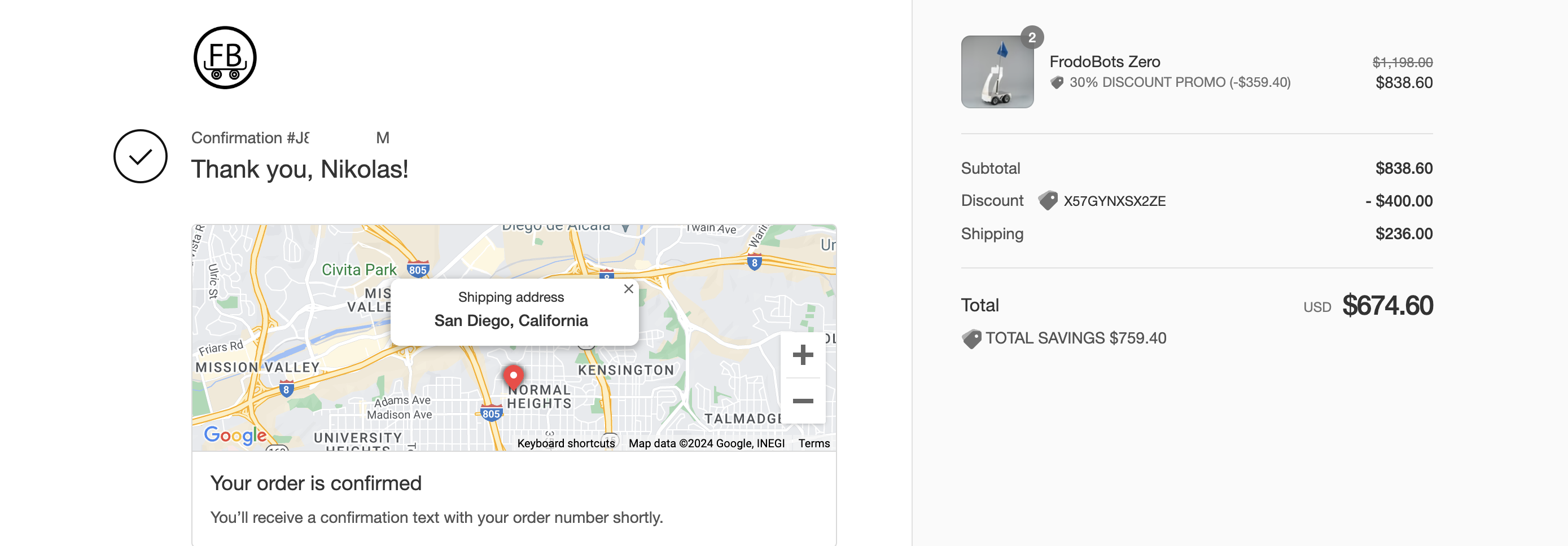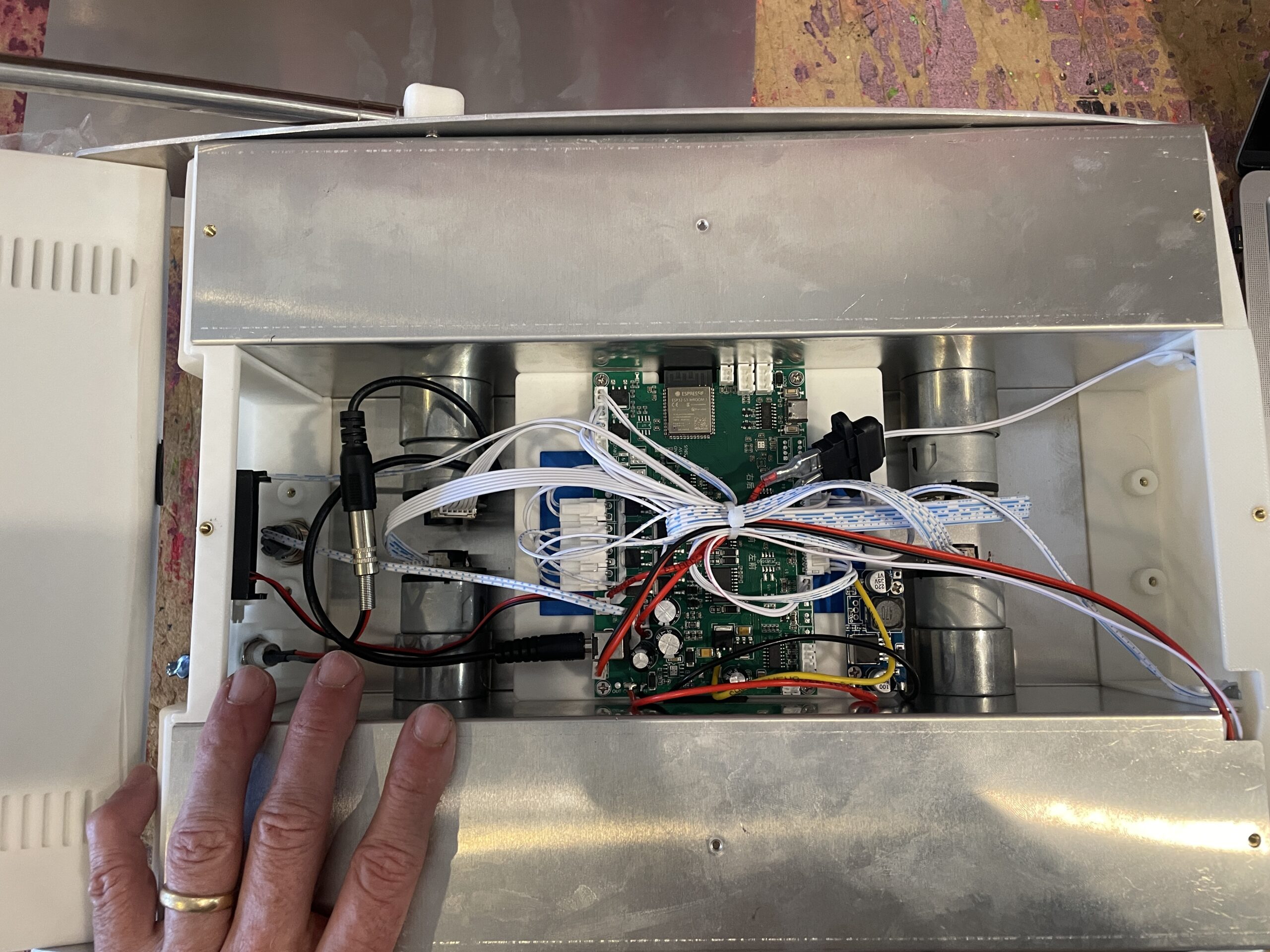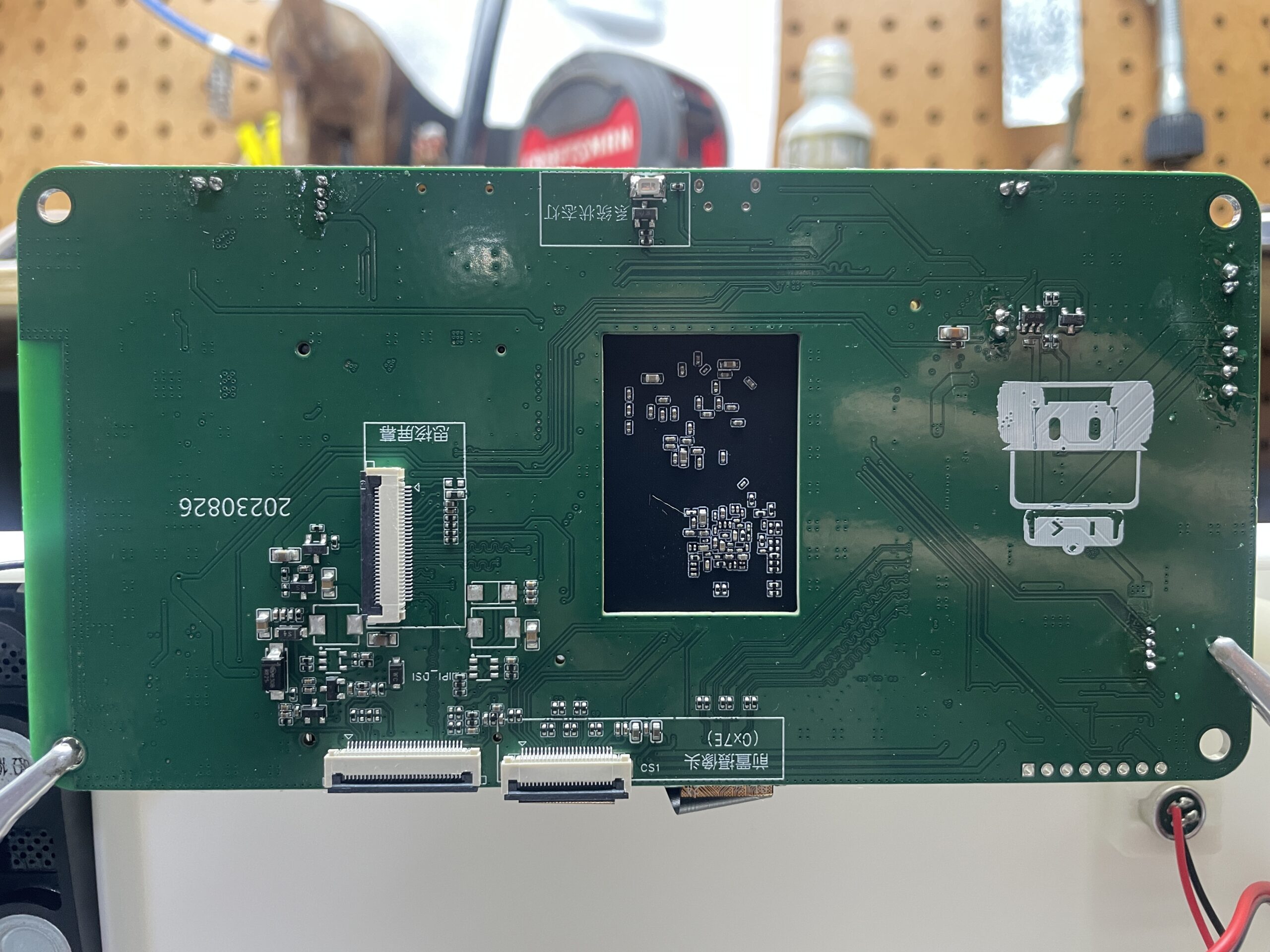“What the heck is that thing?” It’s something I hear via the built-in mic all the time as I’ve been driving my new Frodobot around Normal Heights.
A Frodobot is a small, remote controlled robot designed to “crowdsource a massive global real-world robotics dataset” according to founder Michael Cho.

For most of us, it’s just a fun little RC robot to drive around and wonder at the tech allowing you to control a robot via an internet browser from anywhere in the world. It connects via its own little built in cell phone, so as long as you’ve got cell service where it is, you can drive one.
It’s kind of like the nice version of being one of those drone pilots stationed in Nevada, except instead of executing airstrikes you’re delivering desserts.
You could also be exploring with your buddies; every Frodobot has 2 cameras (front & rear), a mic, and speakers. You could be in Belfast, your buddy could be in Kinshasa, and both of you could be driving robots together in my hometown of San Diego.
Now, that’s not quite reality yet; Frodobots are still super new, and there are only two options to drive one. First, you sign up to drive one in the Frodobots fleet, which for the most part are all on an industrial building’s rooftop in China that’s set up with a maze to navigate through.
The other alternative is to buy your own Frodobot, which is what I did. In fact, I bought 2. They advertised $199 each, which was a little less than what I actually paid, plus $236 in shipping.

They shipped via DHL from Hong Kong, arriving just 4 days after I’d ordered them; super fast!
Now, you might ask, “Nik, why the heck did you buy a Frodobot, never mind two of ’em!?”
First off, I love geeky little things that are new. Second, I thought they’d be fun to use at my other company, Paleo Treats, as part of a local marketing strategy. Third, I think there’s some small income potential here to rent out the bots to people from around the world. Fourth, I’m betting that Frodobots is going to be a DePIN, and I’ve seen how important it is to start early on ordering hardware for DePINs.
The first thing doesn’t need a ton of explaining.
The second thing is pretty straightforward; we’ve been using our little Frodobots to make mini-deliveries of our desserts to other businesses. It’s a fun thing we can do to to collaborate with other businesses. Nothing crazy, just delivering stuff via robot. You can check those out over on the Paleo Treats IG.
The third thing or fourth things are why you might be here.
The question to answer there is:
How do I make money with remote controlled robots?
It’s pretty simple: Frodobots is setting up a marketplace where you can rent out time on your Frodobots to anyone else in the world. A user will log in to something like driver.frodobots.com, pre-pay for time and probably some insurance payment, then they can select your bot, and as long as you have it on and charged up, they can drive it around.
Now, I’ll get a little hand-wavy here and just guess at a couple of reasons that driving a Frodobot might be worth paying for. None of these have been vetted by GK Legal, they’re just ideas.
The Maze
You could set up a local “maze” course in the parking lot (or warehouse) of your business and offer prizes for who completes it the fastest, or, if you have more than one Frodobot, who completes it first out of a group. The prizes might be money, or a coupon to shop at the business, or more time on the Frodobots marketplace.
This seems the most realistic, as Frodobots is already doing this in terms of renting out time for money and then awarding special roles as prizes.
Local Gifting
We think it might be fun to offer up the chance for someone to deliver a gift to their friend. Let’s say you live in Alabama, but your bestie lives down the street from a business with a Frodobot. You might buy something at the business, have ’em put it in the Frodobot basket, then drive it down to your friend’s place as a special delivery. Since there’s a camera, mic, and speaker, you get the fun experience of interacting with your friend through the robot. Sure, you could call ’em, but this is something new: “I delivered your gift myself, with a robot I controlled.” Not everyone can say that at a dinner party.
Local Challenges
Given local street layouts, it might be fun to do a larger version of the maze, where you captain a Frodobot around to local markers, “tag” them, and come back, all under a certain time. If you’re an enterprising type, you could print up QR placards that you affix to the entryway to a business at Frodobot camera height. You could then automate the whole thing, and award prizes based on when the QR was scanned.
Casual Walk
This was actually one of the first ideas I had for this. My nephew lives overseas and my parents live in other states. I thought it would be cool to hand over control of a Frodobot to them before I go on my morning walk with the dogs. In a way, I get to take them along on my walk, get to chat with them and share the same things I’m seeing; when I feed the crows with peanuts, what my little doggies are getting up to, and just have a slightly different experience than they might have if I just Facetimed ’em and they had no choice in what they got to look at.
All those are just ideas of what you can do with a remote controlled robot. Let’s dig in a bit to the tech next, then we’ll finish up with the “What if it becomes a DePIN?” question.
The Tech
Ok, so what’s in ’em? The components are in two separate areas; the sensor package, which is up in the “head” (where the camera, speaker, and mic are) and then the locomotion package, which is down in the body.
I asked ChatGPT to help me go through what I saw up in the head:

On Main Board (labeled TC-RV2216 Core)
- Rockchip RV1126: A high-performance AI processor from Rockchip, typically used in smart cameras, AIoT, and other intelligent devices.
- Rockchip RK809‑2 : This is likely a power management integrated circuit (PMIC) used to manage power requirements of the device, working in conjunction with the main processor.
- SEC 110 K4F8E30 : This appears to be a memory chip from Samsung Electronics (SEC), possibly RAM or flash storage.
- SEC 149 C041 : Another memory chip from Samsung, probably an eMMC flash storage used for the operating system and data storage.
- YXC 24: This might be a crystal oscillator used for timing purposes, with “YXC” being the manufacturer and the numbers representing part code or frequency.
- SP485EL: A low power half-duplex transceiver chip used for serial communication, likely RS-485.
Over by Modem (top right)
- PAM 8610: A digital audio amplifier chip, used for driving speakers and providing sound output.
- Fn-Link 6223a-ST : A Wi-Fi module providing wireless connectivity.
Other components
- Slkor LM2596S-12: A voltage regulator chip, likely used to convert higher voltage down to 12V.
- GG2302: This could refer to a specific part or chip on the board, but without more context, it’s unclear what its function is.
- Buttons for Power On, Reset, Update
- USB OTG: Stands for USB On-The-Go, a USB port that allows the device to switch between acting as a USB host or USB device, enhancing connectivity options.
Then, down in the body, the following.

As you’ll see, GPT wasn’t sure what all of ’em are, but for some of the nerds who’ll read this they may make sense, so I’m leaving them in.
- Espressif ESP32-S3-WROOM‑1 : This is a Wi-Fi + Bluetooth module from Espressif. The ESP32-S3 is a series known for its high performance and versatile application range, including IoT, wearable electronics, and smart home devices.
- ADB210 YRZ #713: This could be a part number or a specific chip, but without more context, it’s difficult to determine its exact function. It might be a part of a larger integrated circuit or a specific identifier for a custom component.
- SS14: This is a Schottky diode, known for its low voltage drop and high efficiency, commonly used in power rectification and as a protection device in circuits.
- 4701, 2202, 1003: These are likely resistor or capacitor codes, indicating their values. For example, 4701 could mean a 470-ohm resistor, and 1003 might be a 100 nF capacitor. These components are fundamental in electronic circuits for controlling voltages and currents.
- SS36: Another Schottky diode, similar to the SS14 but likely with different voltage or current handling characteristics.
- BAXY NO58: This appears to be a specific part number, which could relate to a custom component or a specific version of a standard part. The exact function would depend on the device’s design.
- T4: This could represent a transistor or a specific code for a component. Transistors are used for switching and amplifying electronic signals.
- IRFR7440: This is a power MOSFET, used for switching and amplifying electronic signals in high-power applications.
- THP4 M51: Likely a specific part number or identifier for a component, needing more context to determine its function.
- HIP4081AIBZ : A high-frequency, high-voltage full-bridge N‑channel FET driver IC, used in motor control circuits and other high-power applications.
- WCH CH240C : This might be a USB to serial chip, often used for connecting USB devices to serial interfaces.
- MAX3485: This is a low-power, half-duplex RS-485/RS-422 transceiver, used for serial communication in industrial environments.
- JM32R LM259: This seems to be part of a product code, possibly related to a power management chip like the LM2596 (voltage regulator), but the exact part is unclear.
Ok, so what are the takeaways from that? First, that the team at Frodobots is making little to no money on selling hardware; at $199 this is a pretty darn good price.
Second, the presence of the RV1126 tells me that we’ll see obstacle avoidance as a feature in the future, and I won’t be surprised to see some autonomous driving capabilities like “Hey Frodobot, can you go down and pick up a loaf of bread at the corner store” at some point in the future, where the route gets mapped out, sent to the Frodobot and it drives the route on its own.
Third, the Fn-Link in the head (WiFi connectivity) means we may see not only local programming possibilities wirelessly (though you can probably just plug in to the USB port as well), but there may be some crossover with other DePINs regarding mapping out WiFi networks.
That brings us to the last of the reasons I bought this:
What if Frodobots becomes a DePIN?
A “DePIN” stands for Decentralized Physical Infrastructure Network. It’s a new type of business model where people (or businesses) buy hardware that provides some kind of service. The service can be wireless connectivity, or weather data, or dashcam imagery. Whatever it is, providing the service is rewarded with tokens. Those tokens can usually be traded in cryptocurrency markets.
A good example is Helium Mobile, where you can buy a Helium Hotspot, provide coverage for people using a Helium phone plan, and be rewarded in tokens for the amount of data that flows through your Hotspot.
In the case of Frodobots, you’ve got to ask a few questions: What is that they want? What is the most efficient way to get it? How would you build an incentive structure to achieve that?
As founder Michael Cho has said, the goal of Frodobots is to “crowdsource a massive global real-world robotics dataset”. The DePIN play there seems pretty straightforward:
Provide a way for people to earn tokens by generating a real-world robotics dataset, and make that ability globally accessible, whether you’re the robot owner, driver, or fleet manager.
Of course, any proposed business has to have some value, so how might be figure out the value of this market? According to a market report from Marketsandmarkets.com, “The global AI in Computer Vision market size is […] projected to reach $45.7 billion by 2028, growing at a CAGR of 21.5% from 2023 to 2028.”
Of course, that’s just AI in computer vision, which is only a part of what Frodobots can do. As Forbes has said, “Data is the lifeblood of modern artificial intelligence”, and the real world data these robots can provide at a large fleet level may be staggering.
Again, from the Forbes article:
Getting the right data is both the most important and the most challenging part of building powerful AI. Collecting quality data from the real world is complicated, expensive and time-consuming.
-Forbes, Synthetic Data Is About To Transform Artificial Intelligence
Frodobots may offer an alternative, or better yet, a supplement to synthetic data that isn’t complicated, expensive or time-consuming.
The value of real-world robotics datasets lies in their ability to reduce time, cost, and resources required for developing, training, and validating robotics systems and AI models. You don’t have to look very far to see super smart people diving deep into figuring out how to build foundation models for robots to interact in the real world.
Basically, if you have access to a large data set from the real world, and especially if that dataset involves the interactions between humans and machines, that is potentially a very valuable thing.
Contrary Research unpacks this idea in the Scale AI Report that we *used* to not have enough data.
A long-running issue with building artificial intelligence and machine learning applications was a lack of well-organized data required to build models.
-Peggy Wang & Sachin Maini
Companies like Frodobots may help to start alleviate that data shortage, helping to continue building our models and understanding of the world in new ways.
All of that adds up to why I bought a couple of Frodobots. Frodobots represents this fascinating intersection of technology, business, and community engagement, and I love being a participant at that glorious intersection.
If you buy one and want a code for $50 off, use: 8HSR5H
If you’re looking for a mobile plan for yoru Frodobot, the best I found for unlimited data was a Helium Mobile plan at $20/month and $5 off the first month if you use that link or code KAS6KPL
Rock on!


Leave a Reply